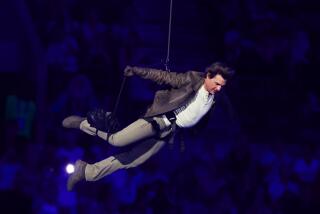From Real Life to Screen Proved Tough Sledding : Movies: Despite being dropped by Columbia and two directors, ‘Cool Runnings,’ the film about Jamaican bobsledders, makes it across the finish line.
“Cool Runnings” is one fish-out-of-water story that may have never been made if it wasn’t true.
“I promise you, as a studio executive, it never would have gotten made. No way,” said “Cool Runnings” producer Dawn Steel, at one time president of Columbia Pictures and earlier production president at Paramount. “I mean, Jamaican bobsledders? That kind of oxymoron says it all,” Steel laughs now on the eve of the film’s nationwide opening Friday.
And, actually, at several points along its rugged course to the big screen, it looked as if the movie might never make it across the finish line.
It was five years ago that Steel was watching the 1988 Winter Olympic games, when the Caribbean island of Jamaica entered two bobsled teams in competition at Calgary, one that crashed out, the other that placed 28th.
She asked herself, who were these guys and what kind of chutzpah was this?
Obviously, the team was having fun. The media was enthralled. And the crowd went bonkers--getting the teammates to pose for pictures, buying T-shirts and creating a frenzy of excitement only matched by another quirky Olympic entrant, bespectacled ski jumper Eddie the Eagle.
As it happened, Jeff Sagansky, then president of Columbia’s sister studio TriStar, bought the rights to the bobsledders’ story a year after the Olympics. When Columbia executive Steel found out about it, she put the project into the development pipeline. Director Michael Ritchie was interested in producing with Fran Kuzui (“Tokyo Pop”) directing. They found some German financial co-partners, who later begged off, derailing its production.
A year later, Steel was out of a job and the project lost its champion, landing in “turnaround,” meaning Columbia made it available to other producers.
Since then, Jamaican bobsledding might be a good metaphor for “Cool Runnings’ ” course to the screen.
After leaving Columbia, Steel went to work as an independent producer at Disney, where she convinced the studio brass to acquire the project and give her the go-ahead to make the $15-million bobsled movie. But when the original budget came in $3 million higher, Disney pulled the plug until Steel shaved a costly location scene out of the script and revived the project.
The PG-rated “Cool Runnings,” which features a hot reggae soundtrack, jazzes up the already extraordinary circumstances that brought the Jamaicans to Calgary. The story downplays the commercial nature of the Olympians’ backers--two enterprising Americans, supported by the Jamaica Tourist Board, who entered the team to promote the island as a vacation spot and to sell merchandise and rum. Rather, the comedy centers on a group of winning athletes who overcome ridiculous odds to compete in a sport that has zero application to the tropics. The real Jamaican bobsledders (the movie focuses on one four-man team and ignores the two-man team) were recruited from the Jamaica Defense Force by the Americans, George Fitch, a former U.S. embassy aide stationed in Kingston who had since opened up a consulting firm there, and Howard Siler, himself a two-time Olympian and former coach of the Canadian and U.S. bobsled teams. The backers picked three soldiers, one college student and a 30-year-old lead singer in a reggae band, all of whom were top sprinters from a country that prides itself on turning out Olympic-level sprinters.
The movie version, directed by Jon Turteltaub (after directors Jeremiah Chechik moved on to do “Benny and Joon” and Brian Gibson dropped out to do “What’s Love Got to Do With It”), turns Siler into Irv, played by John Candy, and his motley team a disparate and jovial bunch.
Team captain Derice Bannock (played by the one-name actor Leon) is the earnest leader. Yul Brenner (Malik Yoba) plays the heavy--with a sentimental streak. Junior Bevel (Rawle D. Lewis) is the spoiled rich kid. Sanka Coffee (comedian Doug E. Doug, now with his own ABC sitcom, “Where I Live”) portrays the comic foil as a dreadlock-sporting rasta-type who races pushcarts. None were Jamaicans, but three of the four have Jamaican ancestry.
“Cool Runnings” was shot on location in February and March of this year--Calgary first, to take advantage of the snow--then to the Jamaican resorts of Montego Bay and Ocho Rios.
Turteltaub said the actors trained as athletes and Doug E. Doug confirms it: “We had to train with this insane bobsled instructor from Montreal who made us lift weights and a bunch of other things I wasn’t used to. I cheated.”
But all of them had to go down the Olympic bobsled track at Calgary’s Olympic Park, pushing the 600-pound sled on its 1,475-feet long course for establishing shots of their race. The filmmakers used 16mm film of the actual crash of the Jamaican bobsledders, which they would not re-create (“way too dangerous,” said Steel), and blew up to 35mm for the movie.
Turteltaub said the gags of the actors breathing vapors, slipping on ice and trying to do a line dance at a country and Western bar “would have been a one-joke movie” if not for their characterizations. “It could easily be a typical underdog story, a formula sports film . . . except it’s anything but. These are Third World people who are warm, well-rounded, intelligent with a sense of humor. They might be unsophisticated in terms of world-class athletic competition, but they personify the Olympic spirit.”
For Doug, it was a chance to be in an uplifting story featuring African-American actors about African-Jamaican sports heroes: “Enough other black-urban-ghetto-violence-crack-baby movies are made. Let’s turn things around,” he said, adding his box-office prediction: “$50 million.”
More to Read
Only good movies
Get the Indie Focus newsletter, Mark Olsen's weekly guide to the world of cinema.
You may occasionally receive promotional content from the Los Angeles Times.











